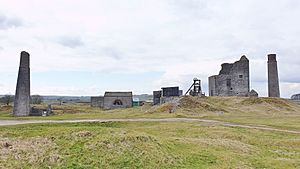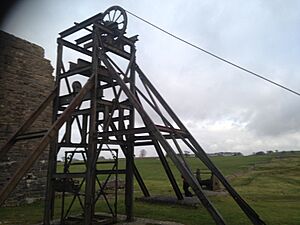Magpie Mine facts for kids

Lead mine remains
|
|
| Location | Sheldon near Bakewell |
|---|---|
| Region | Derbyshire, England |
| Coordinates | 53°12′42″N 1°44′32″W / 53.21167°N 1.74222°W |
| Altitude | 310 m (1,017 ft) |
| Type | Mine |
| History | |
| Periods | 17th century |
| Site notes | |
| Condition | Standing building remains |
| Public access | Footpath |
| Website | https://pdmhs.co.uk/magpie-mine-peak-district/ |
| Official name | Magpie, Dirty Red Soil, Maypit, Horsesteps and Great Red Soil lead mines |
| Designated | 15 January 1974 |
| Reference no. | 1019490 |
Magpie Mine is a very old lead mine near the village of Sheldon in Derbyshire, England. It is no longer used but is well-preserved. This area has been mining lead since Roman times.
Magpie Mine is part of a larger protected area. This area includes five old lead mines. These are Magpie Mine, Dirty Red Soil, Great Red Soil, Maypit, and Horsesteps. This whole site is now a Scheduled Monument. This means it is a special place protected by law.
Mining for lead at this exact spot started at least in the 1600s. The Shuttlebark lead vein opened in 1682. Magpie Mine itself was first recorded in 1740. It operated for over 200 years. Magpie Mine finally closed in 1958. It was the very last working lead mine in Derbyshire. Today, the Peak District Mines Historical Society looks after the site. They have done a lot of work to restore it.
Contents
A Mine's Ups and Downs
Magpie Mine had times when it made a lot of money. But it also had tough times and closed down. For example, it closed in 1793 and again in 1835. This happened because of floods, disagreements, and falling lead prices.
In 1833, there was a very serious disagreement. Fires were set, and sadly, three miners from a nearby mine died. A trial followed, but no one was found guilty. This was because it was hard to tell who was responsible. Also, the miners from Magpie Mine felt they had been provoked.
New Ideas and Equipment
In 1839, a famous mining engineer named John Taylor took over the mine. He brought in many new ideas and equipment. He built new stone buildings. These included the square chimney and the circular chimney, both built in 1840. The square chimney was renovated in 2016.
Other buildings from the 1840s include:
- The agent's house
- The smithy (where metal tools were made)
- The winding house (now gone)
- A circular gunpowder house
- An engine reservoir (to supply water for the engines)
In 1869, a new engine house was built. A large winding engine was installed there. Its winding drum is still visible today.
Deep Shafts and Water Tunnels
The main shaft of the mine was dug in 1823. It goes down more than 200 meters. That's deeper than many tall buildings!
To stop the mine from flooding, a special underground channel was built. This channel is called a sough. It was built between 1873 and 1881. The sough is about 2 kilometers long. It carries millions of liters of water every day. This water drains into the River Wye to the north.
The mine faced financial problems and closed in 1883. It opened for short periods between 1913 and 1923. Then it reopened in 1950. But it finally closed for good in 1958. The steel frame above the main shaft and the corrugated iron winding house are from the 1950s. For safety, all the underground mine shafts are now closed.
Horse Power
At the Red Soil mine shaft, you can see a reproduction of a horse gin. This was a machine powered by horses. Horses would walk in a circle to turn a winding gear. This gear would then lift lead ore up to the surface. It shows how miners used animal power in the past.
Visiting Magpie Mine
You can visit the Magpie Mine site. There are footpaths leading to it from Sheldon, which is about 500 meters north. You can also reach it from lanes to the west, south, and east. It's a great place to learn about mining history!



